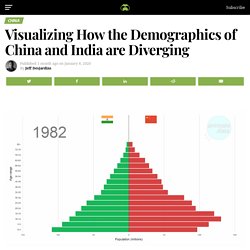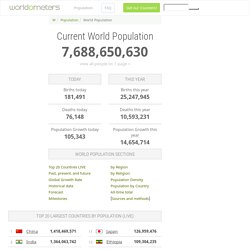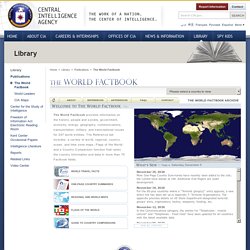

Animation: How the Demographics of China and India are Diverging. Within popular discourse, especially in the West, the profiles of China and India have become inextricably linked.

Aside from their massive populations and geographical proximity in Asia, the two nations also have deep cultural histories and traditions, growing amounts of influence on the world stage, and burgeoning middle classes. China and India combine to be home to one-third of the world’s megacities, and they even had identical real GDP growth rates of 6.1% in 2019, based on early estimates by the IMF.
Diverging Demographics But aside from the obvious differences in their political regimes, the two populous nations have also diverged in another way: demographics. As seen in today’s animation, which comes from AnimateData and leverages data from the United Nations, the two countries are expected to have very different demographic compositions over time as their populations age. The easiest way to see this is through a macro lens: Populations of China and India (1950-2100)
Demographic Transition Model (DTM) Ennuste: Pekingin papat ja Pihtiputaan mummot mullistavat maailmantalouden. Yksi tärkeimmistä megatrendeistä, joka tulevaisuusskenaariossa nostetaan esiin, on väestön ikääntyminen.

Euroopan väestön ikääntyminen on puhuttanut jo pitkään, mutta varsinainen pommi piilee Kiinassa. Nuori työikäinen väestö löytyy jatkossa ennen kaikkea Intiasta ja Afrikasta. Muutoksilla on mullistavia vaikutuksia maailmantalouteen, ja ne ovat aivan oven takana. Väestön kasvu hidastuu ja pysähtyy Maailman väestönkasvu on ollut viime vuosikymmeninä häkellyttävän nopeaa. Maapallon väestön uskotaan kasvavan noin 9,5–11 miljardiin, suunnilleen vuosien 2040–2050 paikkeilla. Tärkein syy kasvun hidastumiseen on se, että niin sanottu hedelmällisyys eli sen montako lasta synnytysikäinen nainen keskimäärin synnyttää, on laskenut maailmanlaajuisesti hyvin nopeasti, noin 2,4:n lapseen. Human Population Through Time. An Interactive Experience - World Population. Animation: Population Pyramids of the 10 Most Populous Countries. China and India may have similar populations today, but they have very different demographic destinies.

While China should see its population fall in the coming decades, India projects to be the most populous country in 2050 by a long shot. By that time, India will have up to 1.7 billion people – and Mumbai will be the largest megacity in the world with upwards of 42 million people. Comparing Population Pyramids These kind of future trends are not evident from the base population figures alone, but they become much clearer when we look at the population pyramids of countries instead. Today’s animated chart comes from PopulationPyramid.net, and it shows a breakdown for each of the 10 most populous countries in the world: A population pyramid, which shows the distribution of a population in terms of age group and sex, can help us to see things like: How many people are being born? Different Makeups Below are three typical patterns for population growth: rapid, slow, and negative. Median age by country, 2017 #Demography #Word. World Map / World Atlas / Atlas of the World Including Geography Facts and Flags - Worldatlas.com - WorldAtlas.com.
Maailman tilastot reaaliajassa. World Population Clock: 7.5 Billion People. World Population: Past, Present, and Future (move and expand the bar at the bottom of the chart to navigate through time) The chart above illustrates how world population has changed throughout history.

View the full tabulated data. At the dawn of agriculture, about 8000 B.C., the population of the world was approximately 5 million. Over the 8,000-year period up to 1 A.D. it grew to 200 million (some estimate 300 million or even 600, suggesting how imprecise population estimates of early historical periods can be), with a growth rate of under 0.05% per year. A tremendous change occurred with the industrial revolution: whereas it had taken all of human history until around 1800 for world population to reach one billion, the second billion was achieved in only 130 years (1930), the third billion in 30 years (1960), the fourth billion in 15 years (1974), and the fifth billion in only 13 years (1987). Wonder how big was the world's population when you were born? Growth Rate. Maat - Globalis.fi. Globalis. Maailman valtiot. The World Factbook.
People from nearly every country share information with CIA, and new individuals contact us daily.

If you have information you think might interest CIA due to our foreign intelligence collection mission, there are many ways to reach us. If you know of an imminent threat to a location inside the U.S., immediately contact your local law enforcement or FBI Field Office. For threats outside the U.S., contact CIA or go to a U.S. Embassy or Consulate and ask for the information to be passed to a U.S. official. Please know, CIA does not engage in law enforcement. In addition to the options below, individuals contact CIA in a variety of creative ways. If you feel it is safe, consider providing these details with your submission: Your full name Biographic details, such as a photograph of yourself, and a copy of the biographic page of your passport How you got the information you want to share with CIA How to contact you, including your home address and phone number. If It Were My Home.